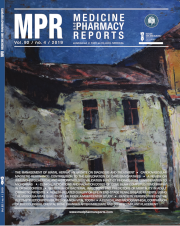Paraneoplastic hypereosinophilia in a patient with peripheral T cell lymphoma, not otherwise specified
DOI:
https://doi.org/10.15386/mpr-1347Keywords:
hypereosinophilia, paraneoplastic syndrome, peripheral T cell lymphoma - NOSAbstract
Under normal physiological conditions, the bone marrow (BM) will have between 1% and 6% eosinophils, translating into a peripheral count of 0.05 – 0.5 x109 /L eosinophils in the blood smear. This process is coordinated by transcription factors with specific roles in differentiation and activation. Secondary eosinophilia may be a paraneoplastic syndrome, related to the presence of a subsequent malignancy, as presented in this case report. Such paraneoplastic manifestations should be addressed properly in order for the patient to receive the best treatment of choice. Even if eosinophilia was associated with B-cell malignancies before, this is a report associating this symptom to a peripheral T-cell lymphoma, not other specified, thus emphasizing the importance of a complex approach for the management of the oncological patient.
Downloads
Published
How to Cite
Issue
Section
License
The authors are required to transfer the copyright of the published paper to the journal. This is done by agreeing to sign the Copyright Assignment Form. Whenever the case, authors are also required to send permissions to reproduce material (such as illustrations) from the copyright holder.

The papers published in the journal are licensed under a Creative Commons Attribution-NonCommercial-NoDerivatives 4.0 International License.

